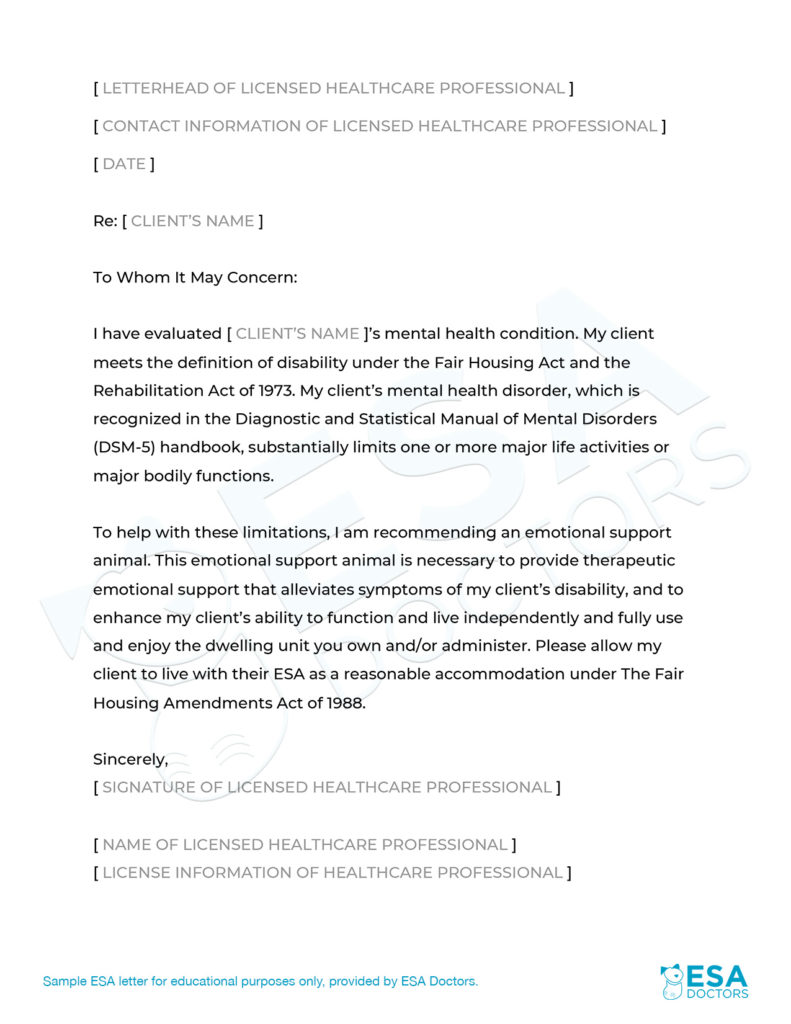Emotional support animal (ESA) have special rights under federal and state laws. Emotional support animals help their owners cope with a wide range of health conditions, including depression, anxiety, PTSD, autism, and phobias. While many pets provide similar emotional and mental health benefits, an animal companion can only qualify as an ESA if the owner obtains an ESA letter.
An ESA letter, and not registration, is the only way to qualify for an emotional support animal under ESA laws. In this article, we’ll give a clear explanation of the following:
- What is an ESA letter?
- What should an ESA letter contain?
- What are the benefits of having an ESA letter?
- Who qualifies for an ESA letter?
- Who is allowed to write an ESA letter?
- How do I use my ESA letter?
- How can I get an ESA letter?
To take advantage of the benefits of being an ESA owner, you need an ESA letter with the right substance from the right source. A deficient ESA letter can be rejected by your housing provider or participating airline and disqualify you from obtaining the advantages of ESA ownership. To learn the critical facts, you need to know about procuring a legitimate ESA letter.
If you need support finding a licensed healthcare provider to see if you qualify for an Emotional Support Animal, we would be happy to assist you.

What is an ESA Letter?
In a nutshell, an ESA letter is a signed letter from a licensed healthcare professional that establishes two things:
- Their client has a mental health impairment that substantially limits one or more major life activities; and
- An emotional support animal would help alleviate symptoms of that impairment.
In other words, an ESA letter is a written and signed recommendation from a licensed therapist who has assessed that an ESA would help with their client’s mental or emotional illness. If you are interested in working with a licensed therapist to see if you ay qualify for an ESA letter – start by filling out this ESA questionnaire.
The form and substance of an ESA letter are largely determined by federal and state housing laws. The most relevant law is the Fair Housing Act and related guidance from the U.S. Department of Housing (HUD). HUD guidelines prescribe what a proper ESA letter should look like. State housing rules for ESAs generally mirror HUD’s rules and provide similar protections.
In prior years, ESAs also had privileges on flights according to the Air Carrier Access Act. However, the U.S. Department of Transportation instituted rule changes that went into effect on January 11, 2021, which no longer give ESAs an automatic legal right to be on planes. However, few airlines will still allow ESAs to board as a courtesy if the passenger submits an ESA letter.
There are a variety of animals that can serve as ESAs. The most common emotional support animals are dogs and cats, but they can also be small birds, hamsters, rabbits, gerbils, other rodents, fish, iguanas, and other small, domesticated animals that are typically kept in the home as pets. An ESA does not require any special training and provides comfort and relief to its owner just by being present.
Once you are in possession of an ESA letter, you have special legal rights which we’ll discuss in a later section.

What should an ESA letter contain?
The exact wording of an ESA letter will vary from practitioner to practitioner, but ESA letters require certain fundamental details to be effective. HUD has published guidelines outlining best practices for what licensed healthcare professionals should include in an ESA letter. An ESA letter should contain the following:
- The client’s name;
- The type and number of emotional support animal(s) for which the reasonable accommodation is sought;
- Whether the client has a physical or mental impairment;
- Whether the impairment(s) substantially limits at least one major life activity or major bodily function; and
- Whether the person needs their ESA because it provides therapeutic emotional support to alleviate a symptom or effect of the disability, not just as a pet.
An ESA letter should also contain the licensed healthcare professional’s signature and license number. It’s important to note that an ESA letter does not name the client’s specific diagnosis or provide detailed information about their condition or medical history. Under HUD’s rules, tenants have a right to privacy regarding sensitive information regarding their mental health.
An ESA letter may or may not have specific details regarding the ESAs themselves (i.e., their names, breed, size, etc.). This is because not all healthcare professionals are capable of verifying these characteristics of the client’s ESA. An ESA letter can also be issued prior to the client actually adopting their emotional support animal. An ESA letter is a recommendation on the part of the licensed healthcare professional, not a verification letter of the specific attributes of the animal that will serve as the client’s emotional support animal.
An ESA letter should be signed but does not have to be notarized. Housing providers also cannot insist that licensed healthcare professionals use a specific form or insist that the healthcare professional make statements under penalty of perjury. HUD instituted these guidelines to stop landlords from denying ESA accommodations by putting up additional barriers to tenants who had submitted appropriate ESA letters.
An ESA letter does not have to be in physical form. Obtaining a hardcopy letter with a wet signature is not always practical, especially for clients who use online therapists. As long as the letter has the relevant information and is signed, it can be a digital copy submitted via email.
Below is a sample ESA letter for reference. Note, however, that your particular ESA letter will look different as licensed healthcare professionals are independently responsible for issuing their letters and will use varying language and formats.
What are the benefits of having an ESA letter?
Under federal and state housing rules, a tenant can submit an ESA letter to their landlord, HOA, or co-op board for special accommodation of their emotional support animal, free of charge.
If you have an ESA letter, the housing provider must reasonably accommodate your emotional support animal, even if the building normally bans pets. Under Fair Housing rules, an ESA is not considered a pet but rather a type of assistance animal that benefits people with mental health disabilities. As a result, an ESA is also not subject to any other restrictions on pets the building may have.
For example, if your building has a policy that only allows cats, that policy does not apply to your emotional support dog. If your building has a weight limit on animals or restricts certain breeds, those policies do not apply to an ESA.
In addition, housing providers are never permitted to charge fees or deposits for an emotional support animal. If the housing provider has a standard policy of requiring a pet deposit or a monthly fee for a pet, that policy does not apply to an ESA. That often saves tenants with emotional support animals hundreds if not thousands of dollars.
An ESA letter can also provide benefits for airlines that have ESA programs. If your airline welcomes emotional support animals, your ESA will be allowed to board the cabin free of charge. Specific requirements for traveling with an ESA will vary from airline to airline (including restrictions on types of ESAs and size), so it’s a good idea to check with your airline to see with their rules are before planning a trip.
Lastly, an additional benefit of having an ESA letter is peace of mind. ESA owners feel more confident knowing they have a signed letter backing up that they have a condition that requires the companionship of an emotional support animal. Many ESA owners suspect that their animal companion functions as an emotional support animal and want documented proof. Even if the ESA owner lives in a pet-friendly building that doesn’t charge pet fees, an ESA letter provides some assurance that they will continue to be able to live with their ESA if they have to relocate.
Who qualifies for an ESA letter?
To qualify for an emotional support animal, a person must have a “disability” as that term is defined under Fair Housing rules. A disability exists if a person has a “mental impairment that substantially limits one or more major life activities.” This can include severe anxiety, depression, phobias, post-traumatic stress disorder, and other psychiatric conditions that limit major life activities like working, sleeping, learning, or caring for oneself.
Guidelines from HUD recognize any mental or psychological disorder as a qualifying condition, such as an intellectual disability, learning disability, or mental illness. HUD also specifically recognizes conditions like autism, emotional illness, drug addiction (other than the illegal use of a controlled substance), and alcoholism.
A licensed healthcare professional with a background in mental health is best suited to help assess whether you meet the standard of having a mental health disability under Fair Housing rules.
Steps to qualifying for an Emotional Support Animal
- Recognize your need for an ESA
- Connect with a licensed therapist/doctor
- Demonstrate your need for an ESA
- Get your document(s)
- That’s it.

Click here to get started on qualifying for your ESA letter.
Who is allowed to write an ESA letter?
When it comes to who is allowed to write an ESA letter, there is often confusion. Contrary to popular misconception, an ESA letter does not have to come from a physician. In fact, most ESA letters are not from physicians but licensed mental health professionals such as psychologists, psychiatrists, counselors, and social workers. HUD also allows an ESA letter to come from other licensed healthcare professionals, such as physicians, physician’s assistants, nurses, nurse practitioners, and even optometrists.
So while your primary care doctor can write an ESA letter, they may not be the best option if they are unfamiliar with your mental health or how an ESA works. Your best bet is a licensed mental health professional that has evaluated your mental health, is familiar with how ESA rules work, and has experience writing effective ESA letters.
Licensed healthcare professionals who offer their services online without in-person meetings are also eligible to issue ESA letters. Remote assessments for emotional support animal qualification have become increasingly popular in recent years and are a great way to find help without the hassle of scheduling an in-person visit.
How do I use my ESA letter?
If you are a tenant looking for your housing provider to accommodate your emotional support animal in your residence, you will submit your ESA letter directly to your landlord. This could be the building’s manager, the owner of your unit, the HOA, or the co-op board, depending on the type of living situation you’re in.
Once you submit your ESA letter, your housing provider must respond promptly to your request (at least within 10 days according to HUD guidelines). A housing provider can only reject a tenant’s ESA request in specific circumstances. For example, if the housing provider has evidence that your ESA poses a safety or health hazard to other residents, it can be proper grounds to deny an ESA request. Smaller landlords are also exempt from Fair Housing rules for ESAs, which include owner-occupied buildings with no more than four units and single-family houses sold or rented by the owner without using an agent. Note, however, that state ESA rules may still apply to these landlords.
Once you have submitted your ESA letter and your landlord has cleared your request, there is no need to carry your ESA letter with you at all times. Your housing provider will have noted that your animal companion is an ESA and accommodation was made for their presence on the premises.
If you plan to use your ESA letter for air travel, you should first check with your airline to see if they are accommodating ESAs. As previously mentioned, most U.S. airlines are discontinuing their ESA programs due to new DOT regulations. If your airline does accommodate ESAs, you need to submit your ESA letter and any other information they require at least 48 hours before your flight. It’s important to check with your airline to see their current rules for assistance animals before making any concrete travel plans with your ESA.

How can I get an ESA letter?
If you’re curious about qualifying for an ESA letter and you have an existing therapist or doctor, that’s probably the best place to start exploring whether an ESA is right for you. Many therapists and doctors, however, are unfamiliar with emotional support animals and how ESA letters work. It’s important to work with someone knowledgeable about the world of ESAs. If you need a licensed healthcare professional specializing in emotional support animal evaluations, ESA Doctors can connect you to a compassionate professional who can help.
The professionals that work with ESA Doctors offer their services remotely, so you don’t have to leave the comforts of your home to see if you are eligible for an emotional support animal. They are experts in emotional support animals and have experience writing ESA letters that work. These healthcare professionals are state-licensed and can issue an ESA letter, which you can present to your housing provider or participating airline for ESA owner benefits.
Click the button below to see if you qualify for an emotional support animal!









I livw in Green Bay Wisconsin and I provided a letter from my Doctor stating that I needed an emotional support animal for my depression and anxiety. When I presented that letter to my property manager she stated that had to have the word “disability” in the letter. It did not have the word disability in it so they denied it. Is it legal for them to do this?
An ESA letter will generally state whether the person has a “disability” as such term is defined for purposes of the Fair Housing Act.
I have had my pup since 2012. she has help me through Anxiety, and depression heaps of time and still. I didn’t register her when she was little. do i still need a letter for the landlord?
If you are trying to qualify your dog as an emotional support animal, then yes, you need an ESA letter from a licensed healthcare professional. It’s irrelevant that you did not qualify your dog as a puppy. The licensed professional would evaluate your needs in the present moment. If you need a licensed healthcare professional familiar with ESAs we can help connect you to one: https://esadoctors.com/esa-questionnaire/
Can I get a note from my primary care physician based on my diagnoses from psychiatrists, or does it have to be specifically from a mental health care provider?
An ESA letter can be from a licensed healthcare professional, which encompasses many types of professionals: physicians, psychologists, psychiatrists, nurses, social workers, counselors, physicians assistants and others. We can help connect you to a licensed professional familiar with ESAs if you are having trouble finding one: https://esadoctors.com/esa-questionnaire/
I have an existing lease that does not allow pets unless agreed upon by the Owner/Agent. A licensed professional has qualified me for an ESA letter and I plan to adopt a pet. How do I initiate the process of adding this addendum to my existing lease? Can I be evicted?
You should inform your landlord that you are requesting accommodation for an emotional support animal and submit your ESA letter to them.
How do you go about broaching a conversation with your doc that you need an ESA letter?
The best thing is to be direct! Your doctor is there to help you. The best person to assess whether you qualify for an ESA letter is a licensed professional that is familiar with your mental health. If you do not currently have a therapist or are having trouble finding one, we can help connect you to one: https://esadoctors.com/esa-questionnaire/
Could I be kicked out of my apartment ? I already have one small calm quiet dog she gives me energy to get out and walk or I’d never step out other is just small quiet little lap dog keeps me. Me calm. Both help me so much and I have seizure and emotion council’s.
If your licensed mental health professional or doctor recommends more than one ESA, your apartment should accept it. Please make sure that you have a legitimate ESA letter so that you can be protected.
how would you go about bringing in an ESA to a seniors lodge? does one person have to be diagnosed or to you do a bunch?
You may be thinking of a therapy animal. Therapy animals are there to help others while an ESA is to help the owner.
If my brother was already diagnosed with Depression and PTSD does he have to pay for another session to ask for an ESA letter? Or is that at the digression of the therapist?
This is at your therapist’s discretion.
Hello there. Canmy FNP write me an ESA letter so that I can keep my pet due to depression which she has prescribed me medication for?
If your FNP is properly licensed and qualified, then yes, they may be able to write you an ESA recommendation letter.